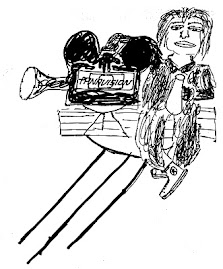 Hope Kaplan is a close friend, a virtual den mother to the music cogniscenti of Los Angeles, and keeps a rather fine blog of her own. Don't ever dare question her rock'n'roll credibility: she was a Tacky Tartan Tart, and you weren't.
Hope Kaplan is a close friend, a virtual den mother to the music cogniscenti of Los Angeles, and keeps a rather fine blog of her own. Don't ever dare question her rock'n'roll credibility: she was a Tacky Tartan Tart, and you weren't. About a week ago, Hope wrote a thoughtful distillation on Radiohead's 1995 hit "Fake Plastic Trees," partnered with "Creep" as one of the band's best-known and loved songs, a cut which even the average over-40 "not too hard/not too lite" radio listener is familiar with and can hum a few bars. As detailed by Hope, songwriter Thom Yorke explores the notion of artificiality in the quest to conform to a societal standard, and how people, both through coercion and through willingness driven by loneliness, are sucked into the charade.
About a week ago, Hope wrote a thoughtful distillation on Radiohead's 1995 hit "Fake Plastic Trees," partnered with "Creep" as one of the band's best-known and loved songs, a cut which even the average over-40 "not too hard/not too lite" radio listener is familiar with and can hum a few bars. As detailed by Hope, songwriter Thom Yorke explores the notion of artificiality in the quest to conform to a societal standard, and how people, both through coercion and through willingness driven by loneliness, are sucked into the charade.  It's a common theme in his other songs, such as "Bodysnatchers" from the "pay what you will" 2007 album IN RAINBOWS ("They got a skin and they put me in"). According to Yorke, the latter song was partly and directly inspired by Ira Levin's novel-turned-cultural-talking-point THE STEPFORD WIVES. Yorke directly referenced the work in his earlier song "A Wolf at the Door" from the 2003 album HAIL TO THE THIEF ("Stepford wives who are we to complain?")
It's a common theme in his other songs, such as "Bodysnatchers" from the "pay what you will" 2007 album IN RAINBOWS ("They got a skin and they put me in"). According to Yorke, the latter song was partly and directly inspired by Ira Levin's novel-turned-cultural-talking-point THE STEPFORD WIVES. Yorke directly referenced the work in his earlier song "A Wolf at the Door" from the 2003 album HAIL TO THE THIEF ("Stepford wives who are we to complain?")More importantly, however, it is readily apparent that his appreciation of the film was already in place back in 1995. Look at the hit song's equally iconic video directed by WELCOME TO THE RILEYS director Jake Scott...
...and look at the final scene from British director Bryan Forbes' 1975 film adaptation. Better yet, watch it, then turn the sound off on this clip, and watch a second time playing the song over it:
(Sorry for the anamorphic squeeze on this -
I tried to stretch it to a proper width but no luck)
Primary research has not turned up any conclusive proof that direct homage was being made by Yorke and Scott to Forbes' staging, and this ain't quite Dark Side of the Rainbow territory, but I think the elements are in place to suggest that the band has had an appreciation for the film and the themes it explored years before they began to actually write about it themselves. And their 1995 song meshed against the 1975 production fits as nicely as a Victorian maxi-dress on Tina Louise.
Then again...This is all so silly... it's just my head. This is all so silly... it's just my head. This is all so silly... it's just my head...







Hi, I had (after you but independently) the same idea you did about the influence of The Stepword Wives (1975) on Scott's Fake Plastic Trees Vid.. The principal connecting feature for me is the use of extremely shallow but variable focus, and I've put a vid with most of the great focus-pulling shots from TSW up on youtube here. Youtube/EMI rejects vids which synch up to the Radiohead, which is too bad, but as you mention in your post, the end user can do that synch him- or herself.
ReplyDeleteI also have a (hurriedly/not especially well-written) blog-post on the topic which collects a bunch of frames from the vid and the movie, if you're interested.
Watching TSW again recently, I think it's a pretty fabulous film. A little under-rated perhaps both because it depends so heavily on a big reveal which can seem cheap/disappointing and because 1975 was such an amazing year for mainstream film-making. It got lost in the crush of Cuckoos Nest, Jaws, Nashville, Shampoo, Barry Lyndon, Dog Day Afternoon, Amarcord, Man who Would be King - 8 consensus classics or near-classics that were also all quite broadly popular at the time.
Still, looking back now, TSW and Cronenberg's Shivers (also from 1975) look like the twin avatars of the modern culture war - one rooted in left-wing fears about conservative reaction, the other rooted in right-wing fears about sexual (esp. gay) revolution. Both left-wing (ERA died, Nixon era child care initiatives died, etc.) and right-wing fears (our pornified gay utopia) came true in my reading of things, hence culture war!